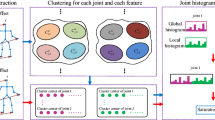Abstract
This paper introduces a new method for human action recognition based on human body skeleton. The proposed method is composed of two phases: an off-line phase which selects the most discriminant human body regions and an online phase to classify the request action. In both phases, we applied the cumulative skeletonized images matrix to extract the action features. The experimental study shows that the proposed method, thanks to salient regions selection and the two-level classification strategy, provides good results comparable in terms of recognition accuracy to the most known and recent state-of-the-art methods.









Similar content being viewed by others
References
Turaga, P., Chellappa, R., Subrahmanian, S., Udrea, O.: Machine recognition of human activities : a survey. J IEEE Trans. Circuits Syst. Video Technol. 18, 1473–1488 (2008)
Gościewska, K., Frejlichowski, D.: Moment shape descriptors applied for action recognition in video sequences. In: Intelligent Information and Database Systems. ACIIDS 2017, vol. 10192, pp. 197–206 (2017)
Shao, L., Chen, X.: Histogram of body poses and spectral regression discriminant analysis for human action categorization. In: The British Machine Vision Conference (BMVC), pp. 1–11 (2010)
Ziaeefard, M., Ebrahimnezhad, H.: Hierarchical human action recognition by normalized-polar histogram. In: 20th International Conference in Pattern Recognition (ICPR), pp. 3720–3723 (2010)
Han, L., Wu, X., Liang, W., Hou, G., Jia, Y.: Discriminative human action recognition in the learned hierarchical manifold space. J. Image Vis. Comput. 28, 836–849 (2010)
Wang, W., Enescu, V., Sahli, H.: Adaptive real-time emotion recognition from body movements. ACM. Trans. Interact. Intell. Syst. 5, 1–18 (2016)
Jiang, Z., Lin, Z., Davis, L.: Recognizing human actions by learning and matching shape-motion prototype trees. IEEE Trans. Pattern Anal. Mach. Intell. 34, 533–547 (2012)
Sekma, M., Mejdoub M., Amar, C.B.: Human action recognition using temporal segmentation and accordion representation. In: International Conference on Computer Analysis of Images and Patterns, pp. 563–570 (2013)
Moussa, M.M., Hamayed, E., Fayek, M.B., Nemr, H.A.E.: An enhanced method for human action recognition. J. Adv. Res. 6, 163–169 (2015)
Wang, H., Klaser, A., Schmid C., Liu, C.L.: Action recognition by dense trajectories. In: International Conference of Computer Vision and Pattern Recognition (CVPR), pp. 3169–3176 (2011)
Mahbub, U., Imtiaz, H., Ahad-Rahman, Md.A.: Action recognition based on statistical analysis from clustered flow vectors. J. Signal Image Video Process. 8, 243–253 (2014)
Tsai, D.M., Chiu, W.Y., Lee, M.H.: Optical flow-motion history image (of-mhi) for action recognition. J. Signal Image Video Process. 9, 1897–1906 (2015)
Pei, L., Ye, M., Zhao, X., Xiang, T., Li, T.: Learning spatio-temporal features for action recognition from the side of the video. J. Signal Image Video Process. 10, 199–206 (2016)
Ravi, D., Wong, C., Lo, B., Yang, G.Z.: Deep learning for human activity recognition: a resource efficient implementation on low-power devices. In: 13th International Conference on Wearable and Implantable Body Sensor Networks, pp. 71–76 (2016)
Johansson, G.: Visual perception of biological motion and a model for its analysis. J. Percept. Psychophys. 14, 201–211 (1973)
Ding, C., Peng, H.: Minimum redundancy feature selection from microarray gene expression data. J. Bioinform. Comput. Biol. 30, 185–205 (2005)
Kuijsten, J.: Adaptive alarm clock using movement detection to differentiate sleep phases. Ph.D. thesis, Eindhoven University Of Technology (2010)
Hilitch, C.J.: Linear skeletons from square cupboards. J. Mach. Intell. 4, 403–420 (1969)
Saeed, K., Tabȩdzki, M., Rybnik, M., Adamski, M.: K3m: a universal algorithm for image skeletonization and a review of thinning techniques. Int. J. Appl. Math. Comput. Sci. 20, 317–335 (2010)
Soofi, E.S.: Principal information theoretic approaches. J. Am. Stat. Assoc. 95, 1349–1353 (2000)
Blank, M., Gorelick, L., Shechtman, E., Irani, M. , Basri, R.: Actions as space-time shapes. In: International Conference on Computer Vision, pp. 1395–1402 (2005)
Jiang, Z., Lin, Z., Davis, L.: Recognizing human actions by learning and matching shape-motion prototype trees. J. Trans. Pattern Anal. Mach. Intell. 34, 533–547 (2012)
Marill, T., Green, D.: On the effectiveness of receptors in recognition systems. J. IEEE Trans. Inf. Theory 9, 11–17 (1963)
Pudil, P., Novovičová, J., Kittler, J.: Floating search methods in feature selection. J. Pattern Recognit. Lett. 15, 1119–1125 (1994)
Seo, H.J., Milanfar, P.: Action recognition from one example. J. IEEE Trans. Pattern Anal. Mach. Intell. 33, 867–882 (2011)
Zhang, Z., Tao, D.: Slow feature analysis for human action recognition. J. IEEE Trans. Pattern Anal. Mach. Intell. 34, 436–450 (2012)
Jargalsaikhan, I., Little, S., Direkoglu, C., O’Connor, N.E.: Action recognition based on sparse motion trajectories. In: IEEE International Conference on Image Processing (ICIP), pp. 3982–3985 (2013)
Luo, G., Yang, S., Tian, G., Yuan, C., Hu, W., Maybank, S.J.: Learning human actions by combining global dynamics and local appearance. J. IEEE Trans. Pattern Anal. Mach. Intell 36, 2466–2482 (2014)
Elshourbagy, M., Hemayed, E., Fayek, M.: Enhanced bag of words using multilevel k-means for human activity recognition. Egypt. Inform. J. 17, 227–237 (2016)
Deepak, N.A., Sinha, U.N.: Analysis of human gait for person identification and human action recognition. J. Commun. Appl. Electron. (CAE) 4, 1–4 (2016)
Liu, H., Shu, N., Tang, Q., Zhang, W.: Computational model based on neural network of visual cortex for human action recognition. J. IEEE Trans. Neural Netw. Learn. Syst. 99, 1–14 (2017)
Author information
Authors and Affiliations
Corresponding author
Rights and permissions
About this article
Cite this article
Mliki, H., Zaafouri, R. & Hammami, M. Human action recognition based on discriminant body regions selection. SIViP 12, 845–852 (2018). https://doi.org/10.1007/s11760-017-1227-z
Received:
Revised:
Accepted:
Published:
Issue Date:
DOI: https://doi.org/10.1007/s11760-017-1227-z




